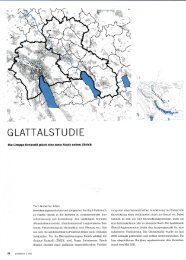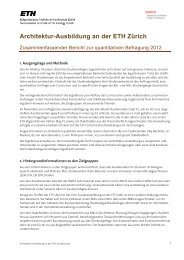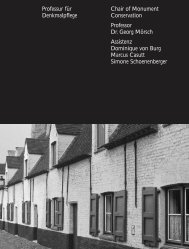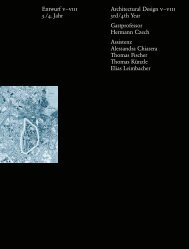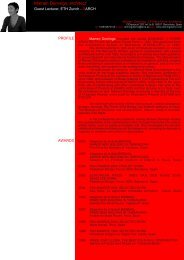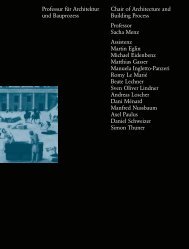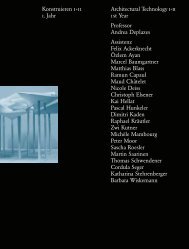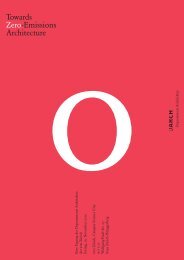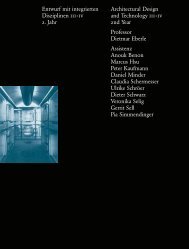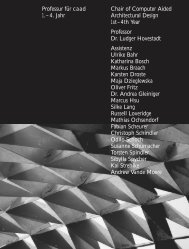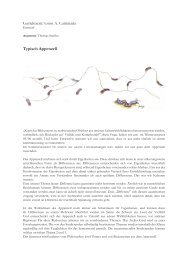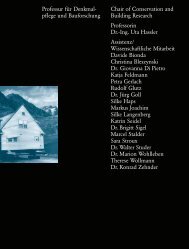Jahrbuch PDF (63MB) - ETH Zurich - ETH Zürich
Jahrbuch PDF (63MB) - ETH Zurich - ETH Zürich
Jahrbuch PDF (63MB) - ETH Zurich - ETH Zürich
Erfolgreiche ePaper selbst erstellen
Machen Sie aus Ihren PDF Publikationen ein blätterbares Flipbook mit unserer einzigartigen Google optimierten e-Paper Software.
noch nützlich. Architektur bedient sich wissenschaftlicher<br />
Methoden und Erkenntnisse, aber sie denkt notwendig<br />
interdisziplinär. Die Wissenschaft von der Architektur<br />
gibt es nicht, hingegen ist es ein differenziertes fachliches<br />
Spektrum von den Natur- und Ingenieurwissenschaften<br />
über die Konservierungs-, Planungs- und Sozialwissenschaften<br />
bis hin zu den Geisteswissenschaften, das in seiner<br />
unvergleichlichen Breite die Identität der Architektur<br />
nachhaltig prägt. Dabei ist Architektur mehr als reine<br />
Wissenschaft. Ihre Schlüsselkompetenzen bleiben Entwurf<br />
und Konstruktion. Sie ist Kunst und Handwerk, ist<br />
Sachwalterin und Gestalterin der gebauten Umwelt, die<br />
sich in täglicher Praxis zu bewähren hat und bei alledem<br />
ganz unmittelbar Verantwortung gegenüber dem<br />
Menschen trägt.<br />
Wie das Departement Architektur sich bemüht hat,<br />
diesem hohen Anspruch auch im Jahr 2008 gerecht<br />
zu werden, möchten wir in dieser Publikation wie in der<br />
Jahresausstellung der Fachwelt und einem interessierten<br />
Publikum nahebringen. Der Band gewährt Einblicke<br />
in Unterricht und Forschung, zeigt ausgewählte Arbeiten<br />
unserer Diplomierenden und Austauschstudierenden<br />
und möchte, soweit das irgend möglich ist, auch etwas von<br />
der Begeisterung und der inspirativen Atmosphäre vermitteln,<br />
die unsere Arbeit trägt und bei aller Anstrengung<br />
zum Vergnügen macht.<br />
Ein herzlicher Dank für ihre Beiträge geht an die<br />
Lehrenden und Studierenden unseres Departements, für<br />
die Koordination von Ausstellung und <strong>Jahrbuch</strong> sowie<br />
die Redaktion an Urs Kurth, für das Lektorat an Ulrike<br />
Steiner und Lynnette Widder, für die Gestaltung an<br />
Sascha Lötscher, Gottschalk + Ash International. Dass<br />
Kooperation das Geheimnis erfolgreicher Arbeit ist,<br />
dafür möge dieses <strong>Jahrbuch</strong> einstehen.<br />
Prof. Dr. Andreas Tönnesmann<br />
Vorsteher des Departements Architektur<br />
surviving sgraffito decoration, executed according to<br />
Semper’s designs, places the exact sciences, to which the<br />
new university has been dedicated since its inception,<br />
into an almost universal relationship with philosophy,<br />
poetry, and the fine arts. What spans before us is a<br />
historical horizon that measures implicitly from antiquity<br />
to the nineteenth century. It is almost unnecessary to<br />
point out that architecture occupies a central place in this<br />
understanding of the sciences. It is the mediator between<br />
the worlds of the just, the beautiful, and the practical.<br />
This concept has since become archaic, but from our<br />
perspective it still has a claim to relevance. Under present<br />
circumstances, it can be difficult to convey the role of<br />
architecture in an academic environment. We can no<br />
longer deploy rhetorical guns like Semper, but his arguments<br />
can still be useful to us, after a certain adjustment<br />
for the progress of history. Architecture makes use<br />
of scientific method and findings, but it necessarily<br />
thinks in interdisciplinary terms. There is no one science<br />
of architecture. On the contrary, it is a diverse spectrum<br />
of fields – from the natural and engineering sciences<br />
through the sciences of conservation, planning, and social<br />
studies, to the humanities. The incomparable breadth of<br />
this spectrum has had a lasting influence on architecture’s<br />
identity. Yet architecture is more than a pure science.<br />
Its key competencies remain design and construction. It<br />
is art and craft and administrator and designer of the<br />
built environment. Architecture must prove itself in daily<br />
practice, while showing immediate responsibility to<br />
humanity.<br />
In the year 2008, the Department of Architecture at<br />
the eth <strong>Zurich</strong> strove to measure up to these high<br />
standards and, with the year’s exhibition and publication,<br />
we would like to present our endeavors to the professional<br />
world and interested public. This volume presents<br />
insight into instruction and research and shows selected<br />
works by our graduating and exchange students. The<br />
yearbook hopes, as far as possible, to impart something<br />
of the ardor and inspiration that support our work and,<br />
in face of all exertion, makes it a pleasure.<br />
We are sincerely grateful to the teachers and students<br />
of our department for their contributions, to Urs Kurth<br />
for coordinating the exhibition and yearbook and his work<br />
as editor, to Ulrike Steiner and Lynnette Widder for<br />
their editorial work, and to Sascha Lötscher, Gottschalk +<br />
Ash International for the design. May this yearbook<br />
vouch for the fact that cooperation is the secret to success.<br />
Prof. Dr. Andreas Tönnesmann<br />
Dean, Faculty of Architecture<br />
7<br />
Vorwort Departement Architektur<br />
Andreas Tönnesmann



